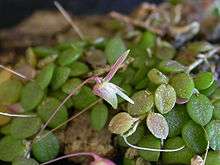Barbosella crassifolia
Barbosella crassifolia is a species of orchid endemic to Brazil.[1][2]
| Barbosella crassifolia | |
|---|---|
 | |
| Scientific classification | |
| Kingdom: | |
| (unranked): | |
| (unranked): | |
| Order: | |
| Family: | |
| Subfamily: | |
| Tribe: | |
| Subtribe: | |
| Genus: | |
| Species: | B. crassifolia |
| Binomial name | |
| Barbosella crassifolia (Edwall) Schltr. (1918) | |
| Synonyms[1] | |
| |
Distribution
Found in southern and eastern Brazil in dense primary forests at an elevation of 950 to 1500 meters. It is known from the states of Bahia, Minas Gerais, Rio Grande do Sul and São Paulo.[2]
Description
Barbosella crassifolia is a miniature sized, warm to cool growing, mat forming epiphyte with ascending ramicauls enveloped by a thin, tubular sheath and carrying a single, apical, prostrate, thickly coriaceous, suborbicular to elliptical, entire apically, obtuse rounded, rounded and contracted below into the nearly absent petiolate base leaf that blooms in the late winter and early spring on a slender, erect, 0.6 to 1.12" [1.5 to .8 cm] long, solitary flowered inflorescence with a minute bract below the middle and an oblique floral bract.
References
- http://apps.kew.org/wcsp/namedetail.do?name_id=19780
- Luer, C. A. 2000. Icones Pleurothallidinarum–XX. Systematics of Jostia, Andinia, Barbosella, Barbrodria, Pleurothallis subgen. Antilla, subgen. Effusa, subgen. Restrepioidia. Addenda to Lepanthes, Masdevallia, Platystele, Pleurothallis, Restrepiopsis, Scaphosepalum and Teagueia. Monographs in systematic botany from the Missouri Botanical Garden 79: 1–140.
| Wikimedia Commons has media related to Barbosella crassifolia. |